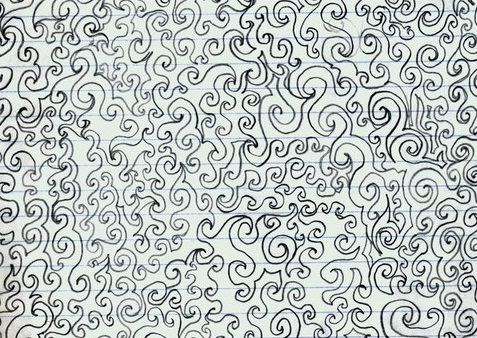What is doodling? It has various definitions, but the best one I think is simply this : drawing any kinds of marks in any kind of way, that just feels good, might have no purpose, and might be entirely unrecognizable to someone else! It’s like (nearly) mindless daydreaming or humming or tapping your fingers on a table. But in these activities and doodling, often times, patterns, themes, and repeated symbols form and reappear. And, of course, you can do it with pencil and paper, or with a stylus and tactile drawing sheets.
Might doodling be connected to creativity? I have no problem believing that doodling is connected in some way to creativity, to freeing the mind, to opening up brain pathways to better graphical communication and thinking. It feels that way for me, and I am comfortable promoting it that way as a selling point for tactile graphics fluency and tactile graphics tools. But, unfortunately, there is very little scholarly work to show that doodling or sketching is connected to creativity, and no rigorous research that I could find. There is a lot of anecdotal supporting evidence, especially among famous people identified as being creative. (Almost everywhere, doodling is referred to as a visual activity – we need to change that!)
This is the only thing I could find, and it is an essay: Schott, G. D. (2011 September) Doodling and the default network of the brain. The Lancet, 378 (9797), 1133-1134. http://www.sciencedirect.com/
Quote from the article:
“The authors found that doodles were produced during states of idleness, boredom, leisure, meditation, and “affective tension”—indecision, concentration, expectation, and impatience. But when an individual doodles, the brain may also be highly creative, being occupied, for example, in solving mathematical problems, or generating ideas for new works in literature, art, or design. For some doodlers, therefore, doodling may be crucial for creativity, whereas for those at the other end of the spectrum, doodling seems to be relaxing or simply entertaining.”
And, there are certainly people there out promoting the idea. See, for example, the TED talk by Sunni Brown, Doodlers, unite!
http://www.ted.com/talks/
(Not surprisingly in a vision-centric world, the speaker calls doodling ‘visual’ thinking rather than ‘spatial’ thinking and doesn’t include touch among the ways we can communicate and learn.) She has a book “The Doodle Revolution: Unlock the Power to Think Differently”.)
I think unstructured or unplanned doodling can be thought of as kinesthetic practice for more structured, purposeful sketching in a planned creative process. So, it seems like doodling is something we can certainly promote along side, say, using tactile graphics for more formal activities like geometry. (Also, I think that kinesthesia should not be referred to solely as “hand-to-eye coordination” but instead as “hand-to-senses coordination”.)
I have a book called “The Back of the Napkin (Penguin Portfolio, March, 2008)” mentioned in this article about the author:
“Business on the Back of a Napkin: Who says doodling is a waste of time? Here are four ways to solve serious business problems with a simple drawing”
http://images.businessweek.
So, grab your Sketchpad and doodle away! Just draw lines, curves, shapes – freely, unplanned, randomly, hard, soft, big, small, with feeling (or not) – and see what emerges, without judgement or evaluation or expectation or restraint.

